Experimental and Numerical Evaluation of a Wildland–Urban Interface Fire Scenario
Abstract
Featured Application
Abstract
1. Introduction
2. Materials and Methods
2.1. Description of the Field Test
2.2. Development of the Full-Physics Model
3. Results
3.1. Experimental Test
3.2. Full-Physics Model Results
4. Conclusions
Author Contributions
Funding
Institutional Review Board Statement
Informed Consent Statement
Data Availability Statement
Acknowledgments
Conflicts of Interest
References
- Bento-Gonçalves, A.; Vieira, A. Wildfires in the wildland-urban interface: Key concepts and evaluation methodologies. Sci. Total Environ. 2020, 707, 135592. [Google Scholar] [CrossRef] [PubMed]
- Li, S.; Dao, V.; Kumar, M.; Nguyen, P.; Banerjee, T. Mapping the wildland-urban interface in California using remote sensing data. Sci. Rep. 2022, 12, 5789. [Google Scholar] [CrossRef] [PubMed]
- Radeloff, V.C.; Hammer, R.B.; Stewart, S.I.; Fried, J.S.; Holcomb, S.S.; McKeefry, J.F. The wildland–urban interface in the United States. Ecol. Appl. 2005, 15, 799–805. [Google Scholar] [CrossRef]
- Kumar, M.; Li, S.; Nguyen, P.; Banerjee, T. Examining the Existing Definitions of Wildland-Urban Interface for California. Ecosphere 2022, 13, e4306. [Google Scholar] [CrossRef]
- Glickman, D.; Babbitt, B. Urban Wildland Interface Communities with Vicinity of Federal Lands that are at High Risk from Wildfire. Fed. Regist. 2001, 66, 751–777. [Google Scholar]
- Radeloff, V.C.; Helmers, D.P.; Kramer, H.A.; Mockrin, M.H.; Alexandre, P.M.; Bar-Massada, A.; Butsic, V.; Hawbaker, T.J.; Martinuzzi, S.; Syphard, A.D.; et al. Rapid growth of the US wildland-urban interface raises wildfire risk. Proc. Natl. Acad. Sci. USA 2018, 115, 3314–3319. [Google Scholar] [CrossRef] [PubMed]
- Schug, F.; Bar-Massada, A.; Carlson, A.R.; Cox, H.; Hawbaker, T.J.; Helmers, D.; Hostert, P.; Kaim, D.; Kasraee, N.K.; Martinuzzi, S.; et al. The global wildland–urban interface. Nature 2023, 621, 94–99. [Google Scholar] [CrossRef]
- Knorr, W.; Jiang, L.; Arneth, A. Climate, CO2; and human population impacts on global wildfire emissions. Biogeosciences 2016, 13, 267–282. [Google Scholar] [CrossRef]
- Krawchuk, M.A.; Moritz, M.A.; Parisien, M.-A.; Van Dorn, J.; Hayhoe, K. Global Pyrogeography: The Current and Future Distribution of Wildfire. PLoS ONE 2009, 4, e5102. [Google Scholar] [CrossRef]
- Masson-Delmotte, V.P.; Zhai, P.; Pirani, S.L.; Connors, C.; Péan, S.; Berger, N.; Caud, Y.; Chen, L.; Goldfarb, M.I.; Scheel Monteiro, P.M. IPCC, 2021. Summary for Policymakers. Climate Change 2021: The Physical Science Basis. Contribution of Working Group I to the Sixth Assessment Report of the Intergovernmental Panel on Climate Change; CSIR: Cambridge, UK; New York, NY, USA, 2021. [Google Scholar]
- Vilà-Vilardell, L.; Keeton, W.S.; Thom, D.; Gyeltshen, C.; Tshering, K.; Gratzer, G. Climate change effects on wildfire hazards in the wildland-urban-interface—Blue pine forests of Bhutan. For. Ecol. Manag. 2020, 461, 117927. [Google Scholar] [CrossRef]
- Manzello, S.L.; Almand, K.; Guillaume, E.; Vallerent, S.; Hameury, S.; Hakkarainen, T. FORUM position paper. Fire Saf. J. 2018, 100, 64–66. [Google Scholar] [CrossRef] [PubMed]
- Chas-Amil, M.-L.; García-Martínez, E.; Touza, J. Iberian Peninsula October 2017 wildfires: Burned area and population exposure in Galicia (NW of Spain). Int. J. Disaster Risk Reduct. 2020, 48, 101623. [Google Scholar] [CrossRef]
- Oliveira, R.; Oliveira, S.; Zêzere, J.; Viegas, D. Human perception of fire hazard in wildland-urban interface areas: A Portuguese survey analysis of spot fires. In Advances in Forest Fire Research; Imprensa da Universidade de Coimbra: Coimbra, Portugal, 2018; pp. 1130–1136. [Google Scholar] [CrossRef]
- Ager, A.A.; Day, M.A.; Alcasena, F.J.; Evers, C.R.; Short, K.C.; Grenfell, I. Predicting Paradise: Modeling future wildfire disasters in the western US. Sci. Total Environ. 2021, 784, 147057. [Google Scholar] [CrossRef] [PubMed]
- Spearing, L.A.; Faust, K.M. Cascading system impacts of the 2018 Camp Fire in California: The interdependent provision of infrastructure services to displaced populations. Int. J. Disaster Risk Reduct. 2020, 50, 101822. [Google Scholar] [CrossRef]
- Guerreiro, J.; Fonseca, C.; Salgueiro, A.; Fernandes, P.; Lopez Iglésias, E.; de Neufville, R.; Mateus, F.; Ribau, C.; Sande Silva, J.; Moura, J.M. Comissão Técnica Independente. In Avaliação dos Incêndios Ocorridos Entre 14 e 16 de Outubro de 2017 em Portugal Continental. Relatório Final; Assembleia da Republica: Lisbon, Portugal, 2018. [Google Scholar]
- Viegas, D.X.; Almeida, M.; Ribeiro, L.M.; Raposo, J.; Alves, D. An overview of the Fires in Portugal in 2017 Global Observations of Forest Cover. In Proceedings of the GOFC Copernicus Meeting, London, UK, 21 November 2017; Available online: https://gofcgold.org/sites/default/files/fireit_meetings/GOFC_Fire_IT_2017/day2/Viegas.pdf (accessed on 4 December 2023).
- Pereira, J.M.C.; Alexandre, P.M.; Campagnolo, M.L.; Bar-Massada, A.; Radeloff, V.C.; Silva, P.C. Defining and mapping the wildland-urban interface in Portugal. Adv. For. Fire Res. 2018, I, 742–749. [Google Scholar] [CrossRef][Green Version]
- Bar-Massada, A.; Alcasena, F.; Schug, F.; Radeloff, V.C. The wildland-urban interface in Europe: Spatial patterns and association with socioeconomic and demographic variables. Landsc. Urban Plan. 2023, 235, 104759. [Google Scholar] [CrossRef]
- Fernandez, F.; Guillaume, B.; Porterie, B.; Ganteaume, A.; Guerra, F. Modelling fire spread and damage in wildland-urban interfaces. In Advances in Forest Fire Research; Imprensa da Universidade de Coimbra: Coimbra, Portugal, 2018; pp. 818–825. [Google Scholar] [CrossRef]
- Potter, M.; Leonard, J. Spray System Design for Ember Attack—Research Findings and Discussion Paper; CSIRO Sustainable Ecosystems: Canberra, Australia, 2011. [Google Scholar]
- Mell, W.E.; Manzello, S.L.; Maranghides, A.; Butry, D.; Rehm, R.G. The wildland-urban interface fire problem-current approaches and research needs. Int. J. Wildland Fire 2010, 19, 238–251. [Google Scholar] [CrossRef]
- Vacca, P.; Caballero, D.; Pastor, E.; Planas, E. WUI fire risk mitigation in Europe: A performance-based design approach at home-owner level. J. Saf. Sci. Resil. 2020, 1, 97–105. [Google Scholar] [CrossRef]
- Biswas, K.; Werth, D.; Gupta, N. A Home Ignition Assessment Model Applied to Structures in the Wildland-Urban Interface; Thermal Performance of the Exterior Envelopes of Whole Buildings XII; Building Technologies Research and Integration Center: Oak Ridge, TN, USA, 2013. [Google Scholar]
- Cohen, J.D. Preventing disaster: Home ignitability in the wildland-urban interface. J. For. 2000, 98, 15–21. [Google Scholar]
- Construction of Buildings in Bush Fire Prone Areas (AS 3959); Technical report, AS 3959; Standards Australia: Sydney, NSW, Australia, 2009.
- Grishin, A.M.; Filkov, A.I.; Loboda, E.L.; Reyno, V.V.; Kozlov, A.V.; Kuznetsov, V.T.; Kasymov, D.P.; Andreyuk, S.M.; Ivanov, A.I.; Stolyarchuk, N.D. A field experiment on grass fire effects on wooden constructions and peat layer ignition. Int. J. Wildland Fire 2014, 23, 445–449. [Google Scholar] [CrossRef]
- Finney, M.A.; Pearce, G.; Strand, T.; Katurji, M.; Clements, C. New Zealand prescribed fire experiments to test convective heat transfer in wildland fires. In Advances in Forest Fire Research; Imprensa da Universidade de Coimbra: Coimbra, Portugal, 2018; pp. 1288–1292. [Google Scholar] [CrossRef]
- Vaz, G.; Raposo, J.; Reis, L.; Monteiro, P.; Viegas, D. Rigid Protection System of Infrastructures against Forest Fires. Fire 2022, 5, 145. [Google Scholar] [CrossRef]
- Santoni, P.; Simeoni, A.; Rossi, J.; Bosseur, F.; Morandini, F.; Silvani, X.; Balbi, J.; Cancellieri, D.; Rossi, L. Instrumentation of wildland fire: Characterisation of a fire spreading through a Mediterranean shrub. Fire Saf. J. 2006, 41, 171–184. [Google Scholar] [CrossRef]
- Butler, K. Wind-Driven Fire Spread to a Structure from Fences and Mulch; NIST Special Publication: Washington, DC, USA, 2022. [Google Scholar] [CrossRef]
- Ghodrat, M.; Shakeriaski, F.; Nelson, D.J.; Simeoni, A. Existing Improvements in Simulation of Fire–Wind Interaction and Its Effects on Structures. Fire 2021, 4, 27. [Google Scholar] [CrossRef]
- Suzuki, S.; Manzello, S.L. Investigating the Effect of Structure to Structure Separation Distance on Firebrand Accumulation. Front. Mech. Eng. 2021, 6, 628510. [Google Scholar] [CrossRef]
- Ghaderi, M.; Ghodrat, M.; Sharples, J.J. LES Simulation of Wind-Driven Wildfire Interaction with Idealized Structures in the Wildland-Urban Interface. Atmosphere 2020, 12, 21. [Google Scholar] [CrossRef]
- Vanella, M.; McGrattan, K.; McDermott, R.; Forney, G.; Mell, W.; Gissi, E.; Fiorucci, P. A Multi-Fidelity Framework for Wildland Fire Behavior Simulations over Complex Terrain. Atmosphere 2021, 12, 27. [Google Scholar] [CrossRef]
- Wickramasinghe, A.; Khan, N.; Moinuddin, K. Determining Firebrand Generation Rate Using Physics-Based Modelling from Experimental Studies through Inverse Analysis. Fire 2022, 5, 6. [Google Scholar] [CrossRef]
- McGrattan, K.; Hostikka, S.; McDermott, R.; Floyd, J.; Weinschenk, C.; Overholt, K. Fire Dynamics Simulator, User’s Guide; FDS Version 6.7.7; NIST Special Publication: Washington, DC, USA, 2021; p. 402. [Google Scholar]
- Mell, W.; Maranghides, A.; McDermott, R.; Manzello, S.L. Numerical simulation and experiments of burning Douglas fir trees. Combust. Flame 2009, 156, 2023–2041. [Google Scholar] [CrossRef]
- Wadhwani, R.; Sullivan, C.; Wickramasinghe, A.; Kyng, M.; Khan, N.; Moinuddin, K. A review of firebrand studies on generation and transport. Fire Saf. J. 2022, 134, 103674. [Google Scholar] [CrossRef]
- Khan, N.; Sutherland, D.; Wadhwani, R.; Moinuddin, K. Physics-Based Simulation of Heat Load on Structures for Improving Construction Standards for Bushfire Prone Areas. Front. Mech. Eng. 2019, 5, 35. [Google Scholar] [CrossRef]
- Wadhwani, R.; Sutherland, D.; Moinuddin, K. Simulated transport of short-range embers in an idealised bushfire. In Proceedings of the 6th International Fire Behavior and Fuels Conference, Sydney, Australia, 29 April–3 May 2019. [Google Scholar]
- EN 10346:2015; Continuously Hot-Dip Coated Steel Flat Products for Cold Forming—Technical Delivery Conditions. CEN: Brussels, Belgium, 2015.
- EN 13501-1; Fire Classification of Construction Products and Building Elements—Part 1: Classification Using Data from Reaction to Fire Tests. CEN: Brussels, Belgium, 2018.
- Dupuy, J.; Maréchal, J.; Morvan, D. Fires from a cylindrical forest fuel burner: Combustion dynamics and flame properties. Combust. Flame 2003, 135, 65–76. [Google Scholar] [CrossRef]
- Mell, W.E.; Manzello, S.L.; Maranghides, A. Numerical modelling of fire spread through trees and shrubs. For. Ecol. Manag. 2006, 234, S82. [Google Scholar] [CrossRef]
- Hostikka, S.; McGrattan, K.B. Large Eddy Simulation of Wood Combustion. In Proceedings of the Ninth International Interflam Conference, Scotland, UK, 17–19 September 2001; Available online: https://tsapps.nist.gov/publication/get_pdf.cfm?pub_id=861077 (accessed on 4 July 2022).
- Browne, F.L. Theories of the Combustion of Wood and Its Control; Forest Products Laboratory, Forest Service, US Department of Agriculture: Madison, WI, USA, 1950. [Google Scholar]
- Abu-Zidan, Y.; Rathnayaka, S.; Mendis, P.; Nguyen, K. Effect of wind speed and direction on facade fire spread in an isolated rectangular building. Fire Saf. J. 2022, 129, 103570. [Google Scholar] [CrossRef]
- Dyer, A.J. A review of flux-profile relationships. Bound. Layer Meteorol. 1974, 7, 363–372. [Google Scholar] [CrossRef]
- Drissi, M. Modeling the spreading of large-scale wildland fires. In Proceedings of the Large Scale Wildland Fires Conference, Missoula, MT, USA, 19–23 May 2014. [Google Scholar]
- Linn, R.R.; Winterkamp, J.L.; Weise, D.R.; Edminster, C. A numerical study of slope and fuel structure effects on coupled wildfire behaviour. Int. J. Wildland Fire 2010, 19, 179–201. [Google Scholar] [CrossRef]
- Tihay, V.; Morandini, F.; Santoni, P.A.; Perez-Ramirez, Y.; Barboni, T. Combustion of forest litters under slope conditions: Burning rate, heat release rate, convective and radiant fractions for different loads. Combust Flame 2014, 161, 3237–3248. [Google Scholar] [CrossRef]
- Wickstrom, U.; Dathinh, D.; McGrattan, K. Adiabatic surface temperature for calculating heat transfer to fire exposed structures. In Proceedings of the 11th International Conference on Fire Science and Engineering Interflam, London, UK, 3–5 September 2007. [Google Scholar]
- Wickström, U. The adiabatic surface temperature and the plate thermometer. Fire Saf. Sci. 2011, 10, 1001–1011. [Google Scholar] [CrossRef]
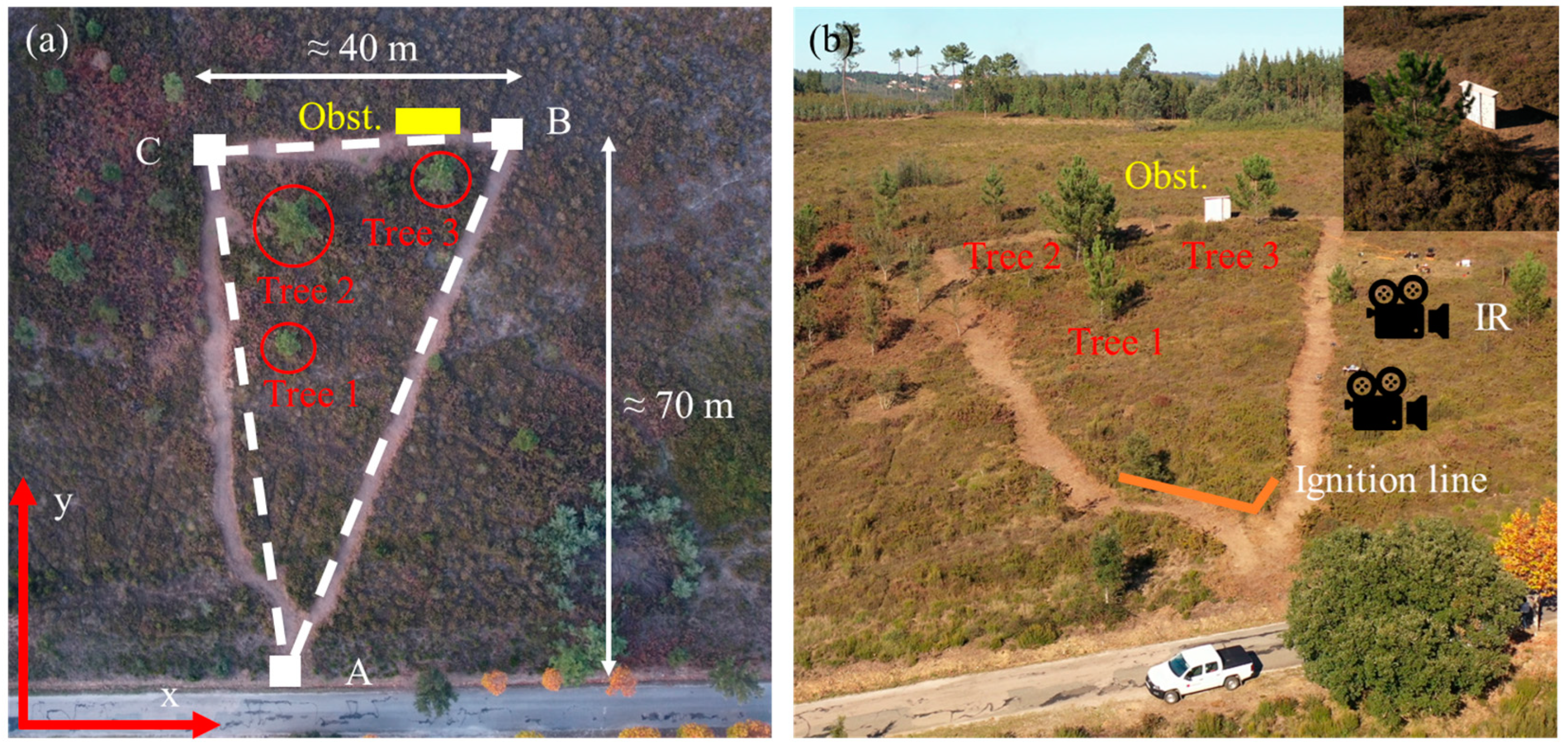
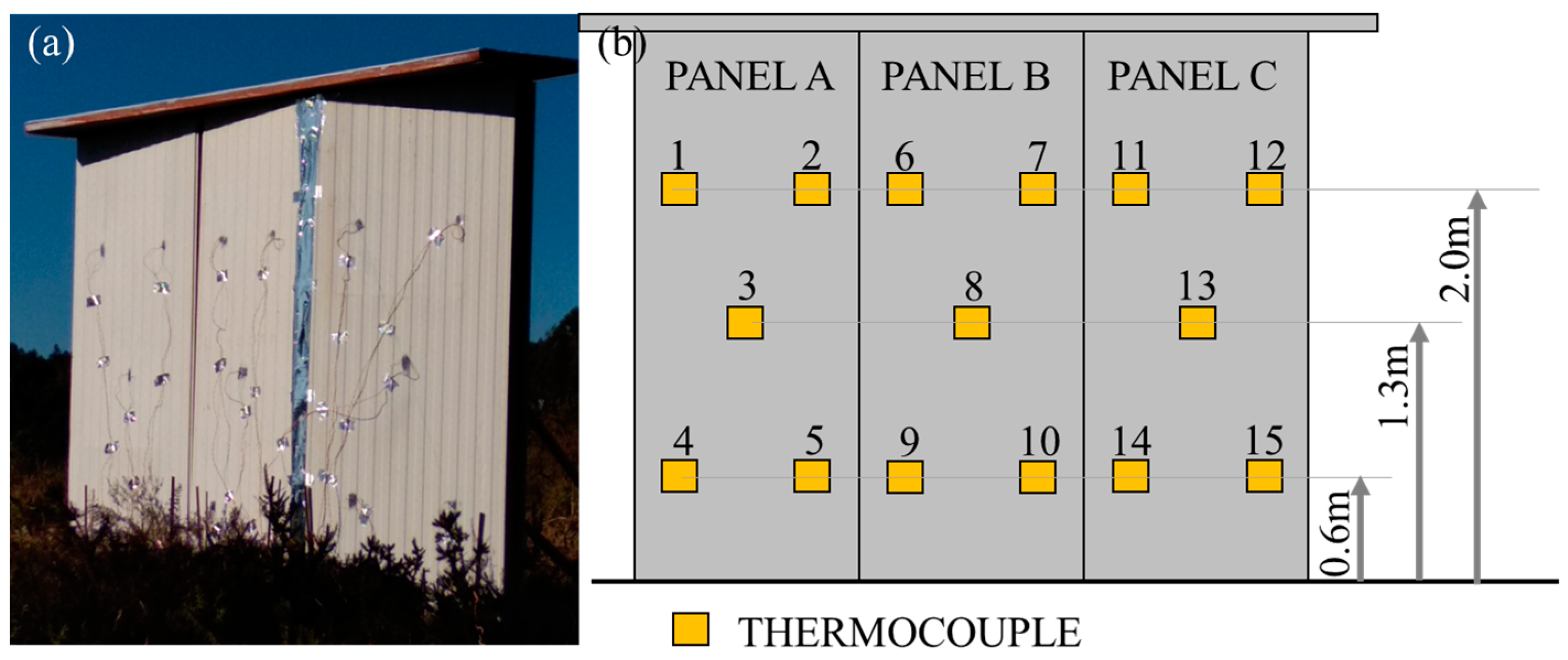
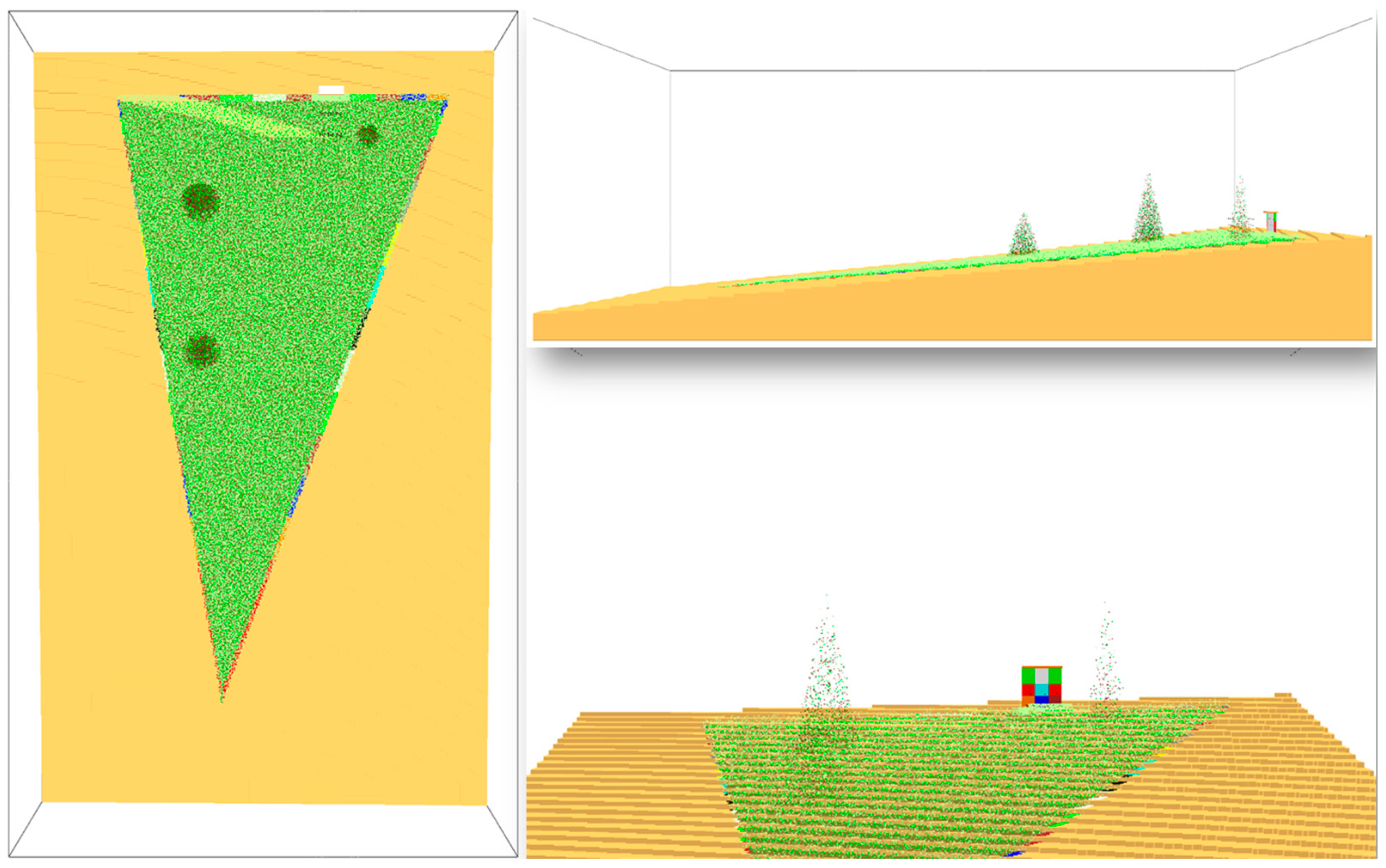
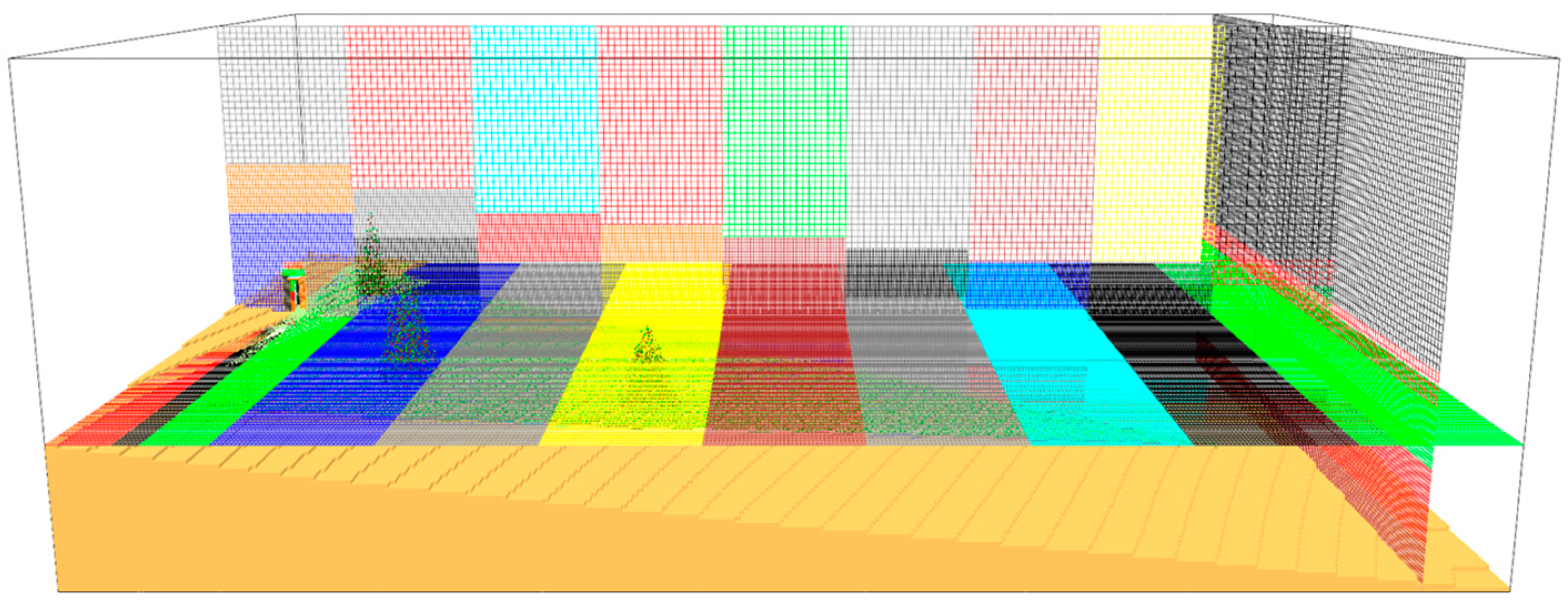
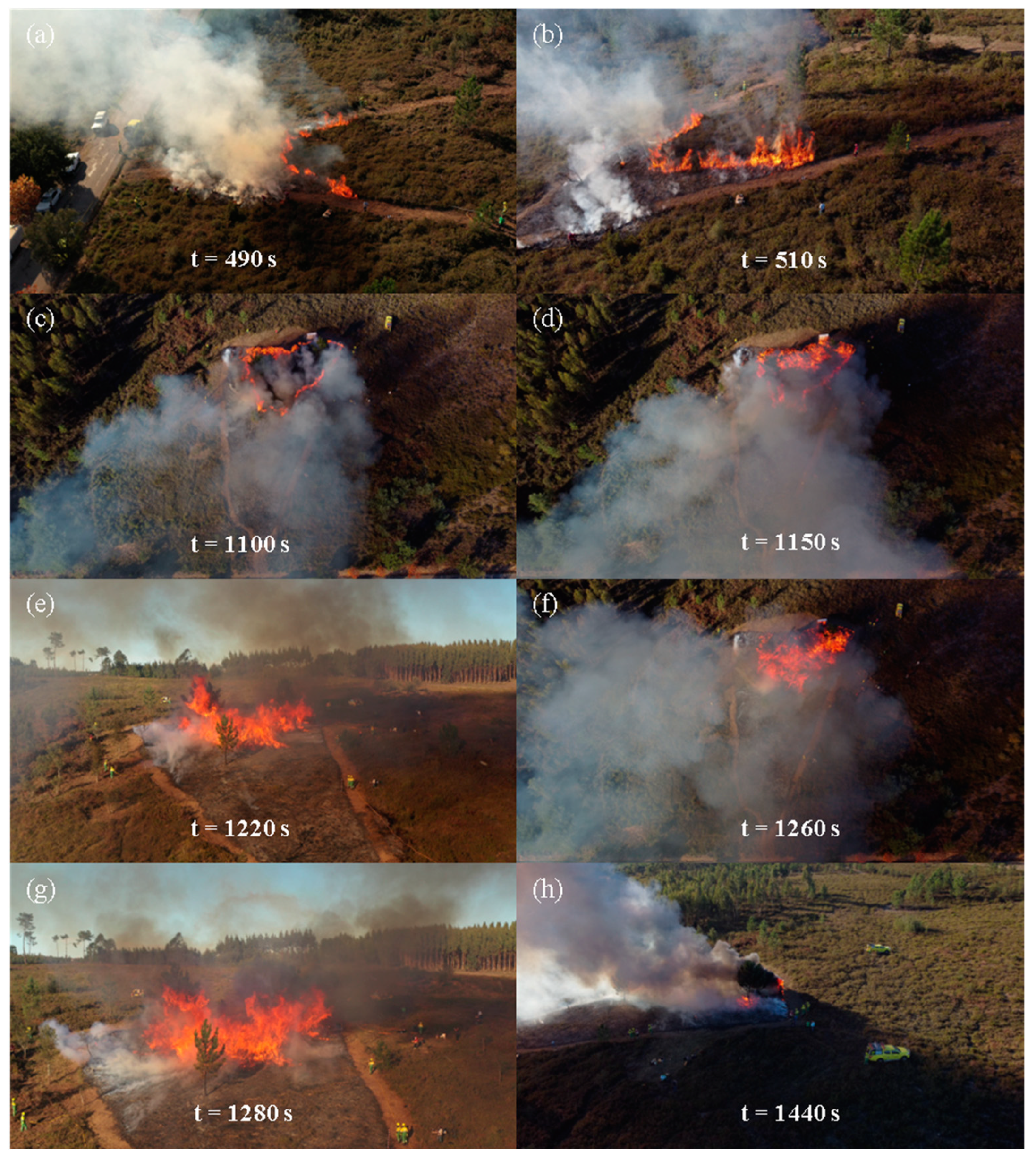
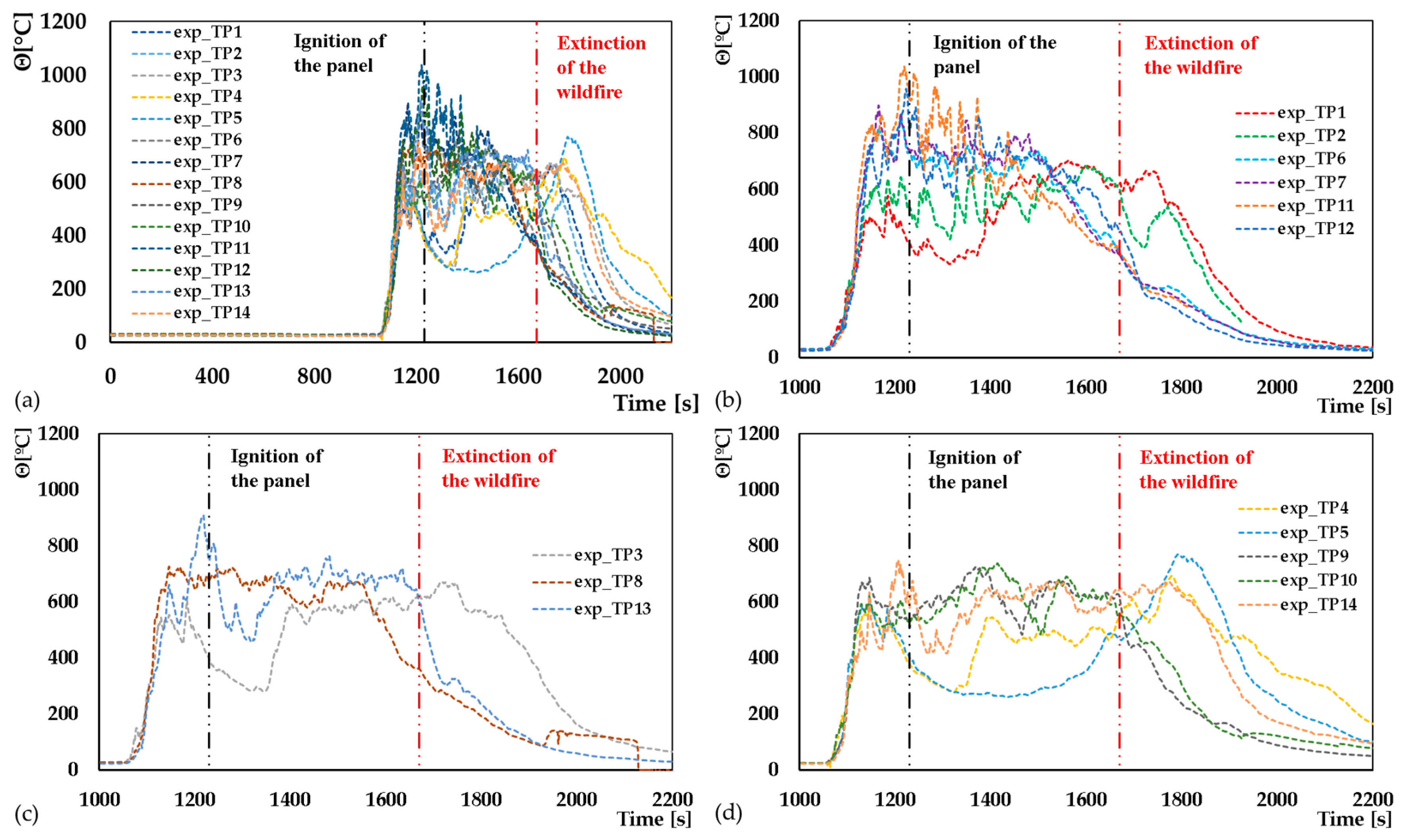
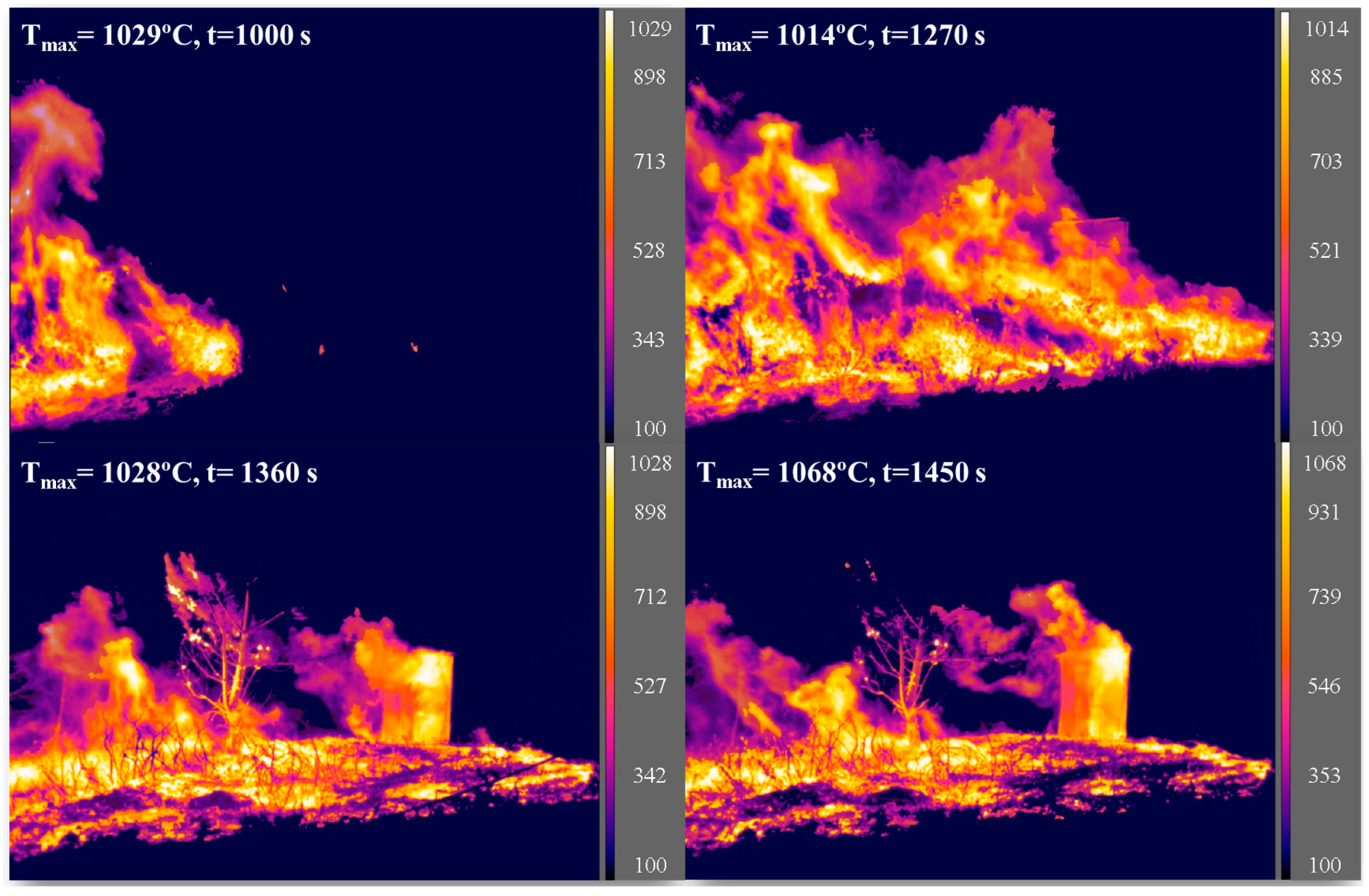
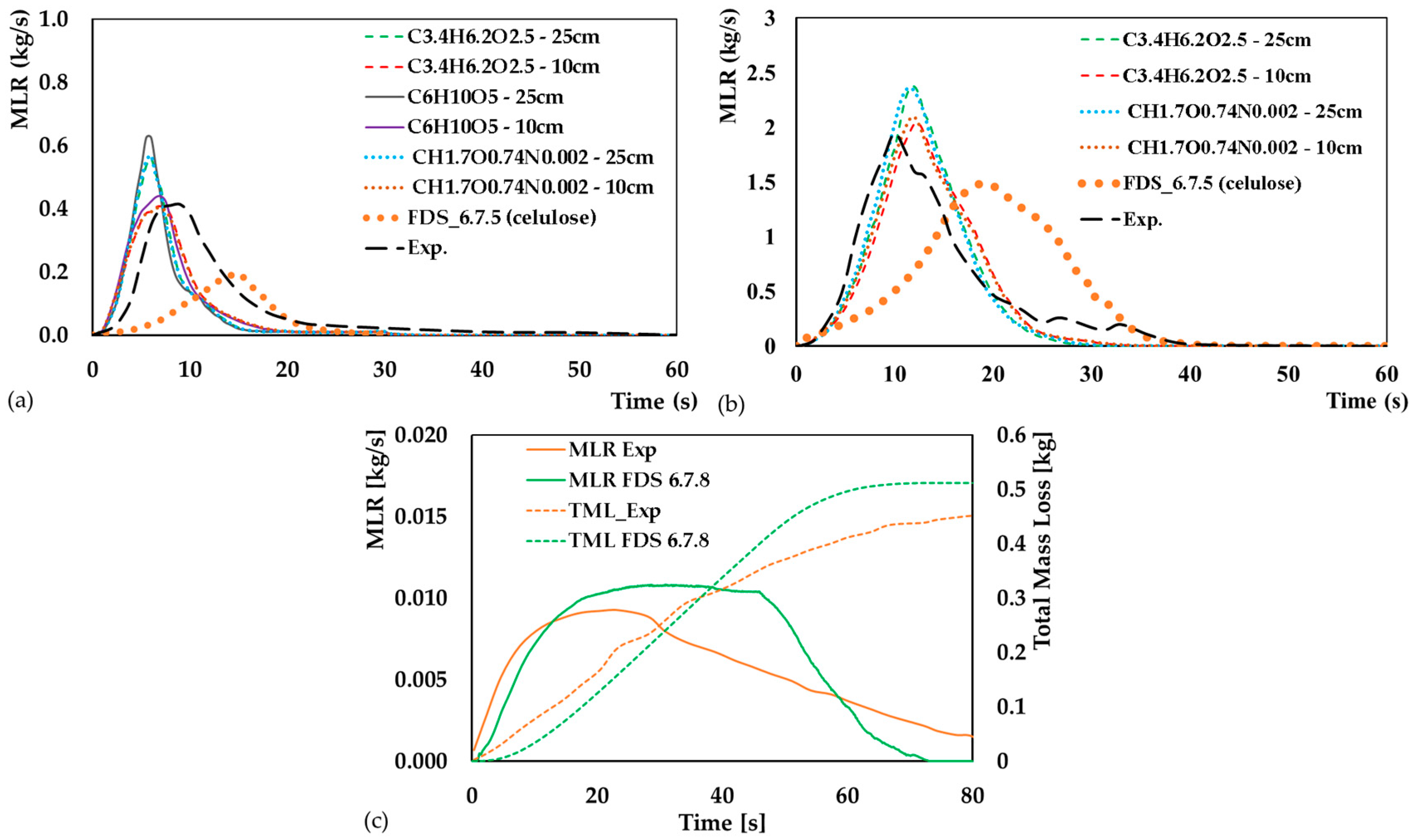
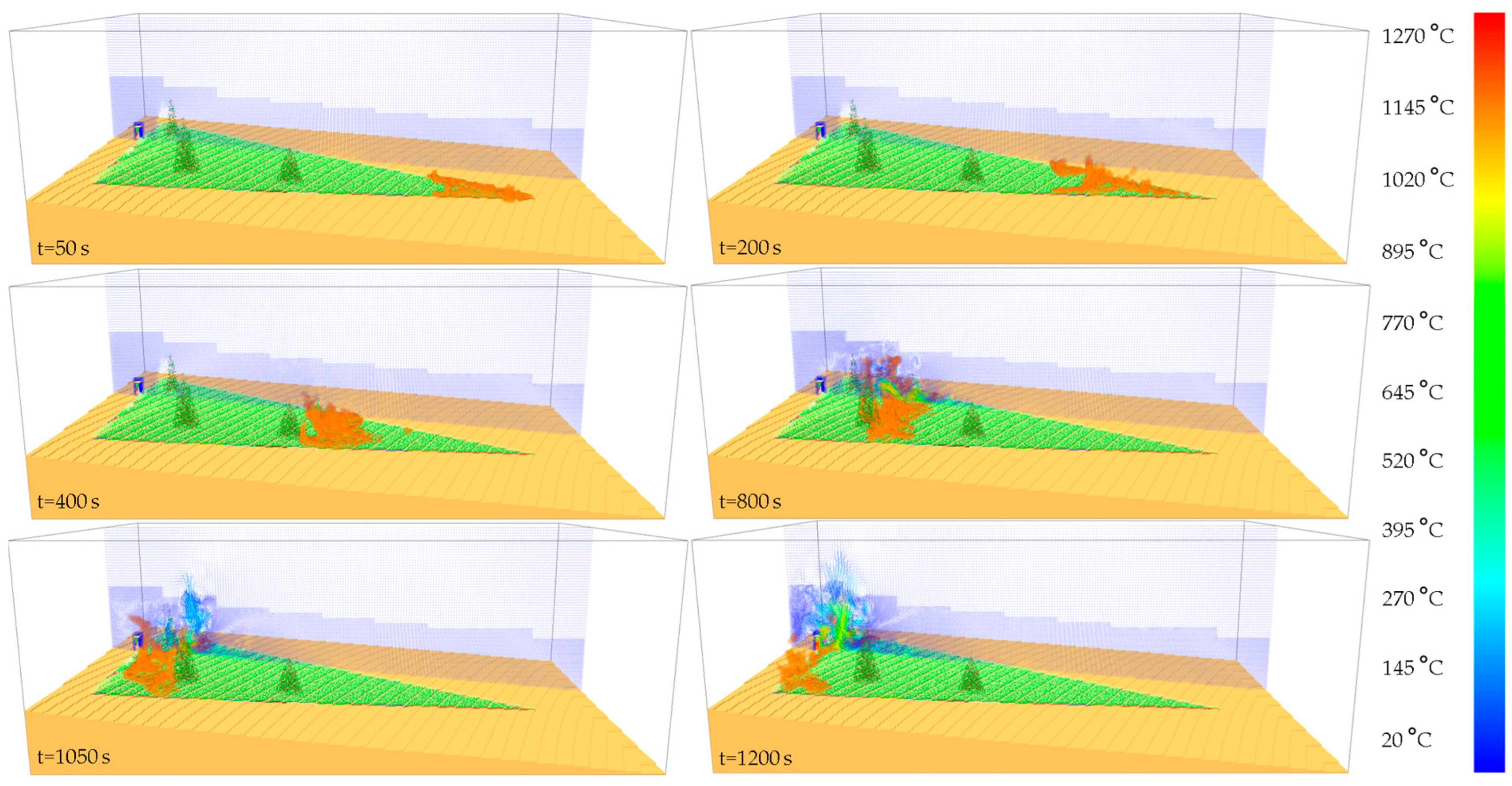

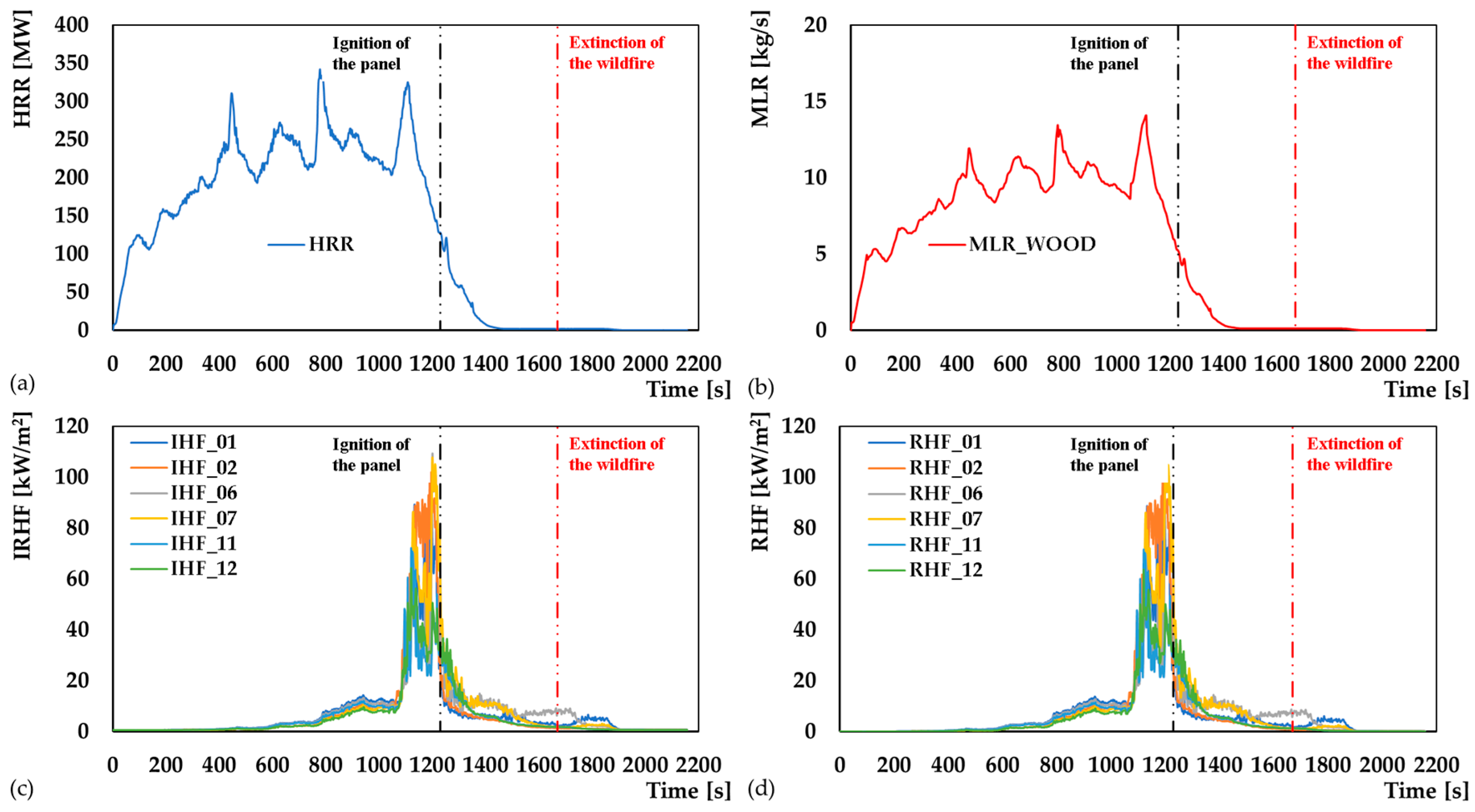
| Quantity | Value | Quantity | Value |
|---|---|---|---|
| Heat of Combustion | 14,516 kJ/kg 1 | Thermal Conductivity 3 | 2.0 W/m K |
| Soot Yield | 0.02 kg/kg | Reference Temperature | 300 °C 4, 100 °C 5 |
| Initial Temperature | 28 °C | Vegetation Density | 514 kg/m3 |
| Heat of Reaction | 416 kJ/kg | Drag Coefficient | 2.8 |
| Specific Heat Capacity 2 | 2.0|1.5|4.184 kJ/kg K | Packing Ratio (f, s, m, l) 6 | 24|68|48|44·10−4 |
| Chemical Formula | CH1.7O0.74N0.002 | SVR 7 (f, s, m, l) 6 | 3940|2667|888|500 m−1 |
| Density 2 | 1000|100|1300 kg/m3 | Length (f, s, m, l) 6 | 0.05|0.10|0.10|0.10 m |
| SHRUB Quantity | Value | GRASS Quantity | Value |
|---|---|---|---|
| Density | 640 kg/m3 | Density | 500 kg/m3 |
| Thermal Conductivity | 0.11 W/m K | Thermal conductivity | 0.1 W/m K |
| Heat of reaction | 416 kJ/kg | Specific heat | 1.5 kJ/kg K |
| Max Reaction Rate | 12 s−1 | Nu_spec/Nu_matl | 0.7/0.3 |
| Drag coefficient | 2.8 | Heat of combustion | 15,600 kJ/kg |
| Moisture Fraction | 0.52 | Heat of reaction | 418 kJ/kg |
| Surface Volume Ratio | 4100 m−1 | Drag coefficient | 1.0 |
| Length | 0.05 m | Reference temperature | 300 °C |
| Geometry | cylindric | Pyrolysis range | 80 °C |
| Quantity | Steel | Foam | Char | Ash |
|---|---|---|---|---|
| Density (kg/m3) | 7870 | 40 | 300 | 67 |
| Specific heat (kJ/kgK) | 0.465 | 1.0 | 2.04 | 1.96 |
| Thermal Conductivity (W/mK) | 60 | 0.05 | 0.052 | 0.1 |
Disclaimer/Publisher’s Note: The statements, opinions and data contained in all publications are solely those of the individual author(s) and contributor(s) and not of MDPI and/or the editor(s). MDPI and/or the editor(s) disclaim responsibility for any injury to people or property resulting from any ideas, methods, instructions or products referred to in the content. |
© 2023 by the authors. Licensee MDPI, Basel, Switzerland. This article is an open access article distributed under the terms and conditions of the Creative Commons Attribution (CC BY) license (https://creativecommons.org/licenses/by/4.0/).
Share and Cite
Craveiro, H.D.; Fiorini, C.; Laím, L.; Guillaume, B.; Santiago, A. Experimental and Numerical Evaluation of a Wildland–Urban Interface Fire Scenario. Appl. Sci. 2023, 13, 13236. https://doi.org/10.3390/app132413236
Craveiro HD, Fiorini C, Laím L, Guillaume B, Santiago A. Experimental and Numerical Evaluation of a Wildland–Urban Interface Fire Scenario. Applied Sciences. 2023; 13(24):13236. https://doi.org/10.3390/app132413236
Chicago/Turabian StyleCraveiro, Hélder D., Cesare Fiorini, Luís Laím, Bruno Guillaume, and Aldina Santiago. 2023. "Experimental and Numerical Evaluation of a Wildland–Urban Interface Fire Scenario" Applied Sciences 13, no. 24: 13236. https://doi.org/10.3390/app132413236
APA StyleCraveiro, H. D., Fiorini, C., Laím, L., Guillaume, B., & Santiago, A. (2023). Experimental and Numerical Evaluation of a Wildland–Urban Interface Fire Scenario. Applied Sciences, 13(24), 13236. https://doi.org/10.3390/app132413236








